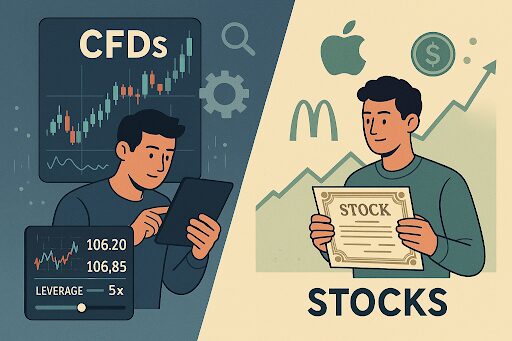You’re poking around in the trading world and keep seeing people throw out “CFDs” and “stocks” like they’re the same thing. They’re not. Sure, both live in the financial markets, but they work in totally different ways.
If you’re just getting started, all those terms—margin, leverage, overnight financing—can feel like a mess. Let’s break it down like we’re sitting over coffee and you just asked, “What’s the difference anyway?”
Owning vs. Borrowing
With stocks, you’re buying a slice of a company. Own one share or a hundred—it’s still yours. Dividends, price gains, long-term holding, all part of the deal.
CFDs, or “Contracts for Difference,” are different. You don’t own the asset—you just trade on price moves. It’s like renting the movement instead of buying the house. Feels lighter, but it’s riskier too. That’s where forex brokers like AxiTrader Limited come in, offering access to CFDs and other markets while providing tools and education to help you understand margin, leverage, and risk before diving in.
Leverage and Margin—The Double-Edged Sword
CFDs use leverage, so you only put down a small margin but control a bigger position. Wins can stack up fast—but so can losses.
Stocks don’t work that way. You pay full price, and unless you’re on margin, you can’t lose more than you invest. Safer, but it takes more upfront cash.
Short Selling Without the Circus
Let’s say you think a stock is headed down. With traditional shares, short selling is complicated—you’ve got to borrow shares, sell them, then buy them back later. Not exactly beginner-friendly.
With CFDs? You just click “sell.” Done. Betting on falling prices is baked right in. It’s one of the reasons active traders like them—they can move in both directions without jumping through hoops. The flip side: easier short selling also means it’s easier to overtrade. CFDs and features like short selling, leverage, and broad market access are shaping the future of trading, giving more people tools that were once reserved for professionals.
Overnight Costs—The Sneaky Part
Hold a CFD overnight and you’ll pay financing fees—small at first, but they build up fast.
Stocks don’t have that. You can hold for years with no extra costs beyond basic commissions, which is why long-term investors stick with them.
Market Access—More Doors Open
CFDs give you range—stocks, indices, currencies, commodities, even crypto, all in one place. Stocks stick to companies, which keeps things simpler but narrower.
That’s why the right broker matters. Some offer both CFDs and forex plus guides on margin and risk, so you’re not trading blind.
The Risk Reality Check
Here’s the blunt truth: most beginners underestimate CFDs. The leverage feels exciting. Fast trades feel empowering. But it cuts both ways. One wrong move, and the account balance can tank.
Stocks move slower. They require more upfront money, sure, but there’s something grounding about owning the actual shares. They’re not risk-free—companies can go bust, markets can drop—but they don’t have that leverage trap hanging over them.
Neither is “better” across the board. It really comes down to what you want out of trading. Do you want to build wealth slowly, maybe collect dividends, and not stress every time the market wiggles? Stocks. Do you want to trade actively, take short-term positions, and you’re okay with higher risk for the shot at higher returns? CFDs.
Which Way Should You Go?
It doesn’t matter what anyone on a forum says. It matters what you can actually handle. If the thought of losing money overnight makes you scared? Maybe don’t start with leveraged CFDs. If sitting on shares for years feels boring? You might like the flexibility of CFDs.
Start small. Try both. Learn the ropes on a demo account or with small positions before throwing in real money. And don’t chase trades just because someone online said they made a fortune.

